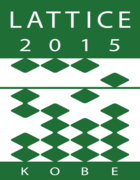Speaker
Dr
Prasad Hegde
(Central China Normal University)
Description
The QCD chiral phase transition for small values of baryon chemical potentials is expected to be second-order and the dependence of its transition temperature on the chemical potentials is thus controlled by the dependence of $O(N)$ scaling functions on the reduced temperature variables. Though the transition is merely a crossover at physical quark mass, the dependence of the chiral phase transition temperature is nevertheless of interest as it could be related to the freeze-out curve that is obtained from an analysis of hadron multiplicities in heavy-ion collisions.
In this talk we will report on our ongoing work on the leading-order dependence of the chiral phase transition temperature as a function of the light and strange quark chemical potentials i.e. the curvature of the chiral phase transition temperature with respect to the light and the strange chemical potentials. We have performed simulations using the Highly Improved Staggered Quark (HISQ) action on lattices with temporal extent $N_\tau=6$ with two degenerate light quarks and a strange quark. The strange quark mass was chosen to be fixed to its physical value and the light quark mass was adjusted in order to have five values of the pseudo-Goldstone pion mass ranging from 160 MeV to about 80 MeV in the continuum limit. The comparison of the resulting curvatures from the current study with those from previous investigations will also be discussed.
This study is on behalf of the BNL-Bielefeld-CCNU collaboration.
Primary author
Dr
Prasad Hegde
(Central China Normal University)
Co-author
Prof.
Heng-Tong Ding
(Central China Normal University)

